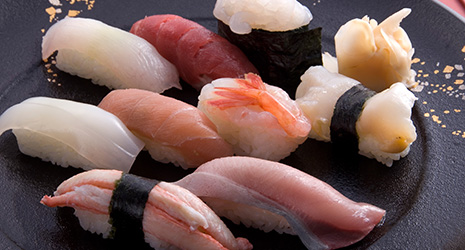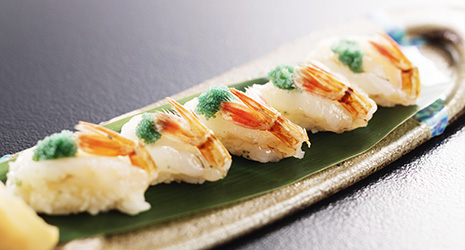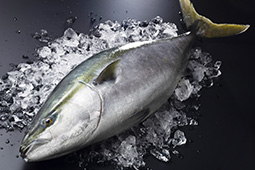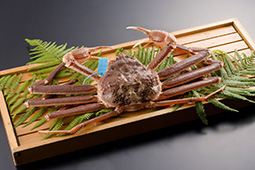February 2023
- English
- 日本語
Ishikawa Wintertime Sushi

Sushi topped with buri (front right) and other seafoods from Ishikawa Prefecture 
Sushi topped with gasuebi shrimp and their green-colored eggs

Buri caught in Ishikawa Prefecture 
Kano-gani crab caught in winter in Ishikawa Prefecture

Ishikawa Prefecture is located near the center of Honshu facing the Sea of Japan. In the winter months, the area attracts a large number of visitors who come to enjoy sushi with seasonal seafood toppings.

Ishikawa Prefecture has a coastline extending over approximately 580 kilometers, with the Noto Peninsula in the northern area jutting out into the Sea of Japan.
The sea of this region is one of Japan’s foremost fishing grounds. Here the cold current from the north and the warm current from the south intersect, forming plankton-rich waters which attract fish and shellfish from both cold and warm sea areas. Due to the diverse topography of the fishing grounds, including deep and shallow waters and rock reefs, many varieties of fish and shellfish can be caught.
These abundant fishery resources have given rise to the development of a culinary culture in Ishikawa Prefecture that uses fresh seafood. One of the most popular types of cuisine is sushi.
“What sets Ishikawa sushi apart is the variety of ingredients used,” says Teranishi Masaaki, chairman of the Ishikawa Sushi Store Environmental Sanitation Association. “Particularly during the winter months, many varieties of seasonal seafood are available, and customers travel from all over the country to enjoy them.”
One of the seasonal sushi toppings in winter in the Hokuriku region, which includes Ishikawa Prefecture and the neighboring prefectures of Toyama and Fukui, is buri, or yellowtail. Buri migrate over a wide area of Japanese waters, arriving in Ishikawa Prefecture from late fall to early winter. The kanburi, or winter yellowtail, caught in the Sea of Japan during this season is renowned for its rich fatty flavor. Kanburi caught on the coast of Ishikawa Prefecture in set nets* from November through February that weigh 7 kilos or more are certified by the Ishikawa Fisheries Cooperative and sold under the brand name “Tennen-Noto-Kanburi” (Natural Noto Yellowtail). Sushi topped with Tennen-Noto-Kanburi is a special wintertime treat.
Other well-known Ishikawa wintertime sushi toppings are kano-gani crab and kobako-gani crab. Kano-gani crab is the male snow crab and the catch season is November through March. Its thick legs are packed full of meat used for sushi. Kobako-gani crab is the female snow crab. Around half the size of the kano-gani crab, inside its carapace are orange-colored immature eggs called uchiko and brown granular eggs called sotoko, both of which are edible. The fishing season for kobako-gani crab is limited to around six weeks from November through December in order to conserve the species, so the flavor can only be enjoyed for a very brief period in winter.

Amaebi shrimp is another well-known sushi topping, but the rarer gasuebi shrimp is now becoming increasingly popular. Caught along with amaebi, brown gasuebi have been regarded as less attractive than the beautiful red amaebi. Since they also do not keep fresh for as long, they used to be an exclusively local delicacy. This situation has changed in recent years, however, as their reputation for being sweeter and richer in flavor than amaebi spread beyond the prefecture. As a result, gasuebi are now more expensive than amaebi. “Ishikawa also offers a variety of other seafood in winter, such as cod, squid, and sea cucumbers,” says Teranishi.

Sake brewing is another longstanding tradition of Ishikawa Prefecture, dating back centuries. The Noto Toji originating in Oku-Noto area make up one of Japan’s four great toji guilds** and work in many sake breweries in Ishikawa Prefecture. Sake pairs perfectly with sushi. Ishikawa sake that pairs well with kanburi and kobako-gani crab sushi is served at many sushi restaurants. There is no better time to enjoy this sake and sushi combination than the cold of winter.
* Set net fishing is a passive fishing method that uses a net anchored in the ocean to catch migrating fish that enter the nets.
** Head brewer responsible for managing the sake brewing process. The four great toji are said to be the Noto toji, Nanbu toji (Iwate Prefecture), Echigo toji (Niigata Prefecture), and Tamba toji (Hyogo Prefecture).

